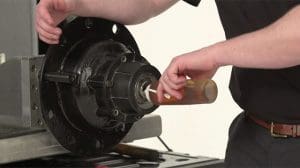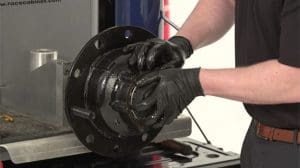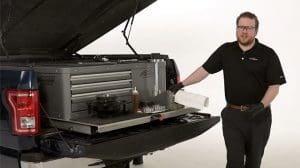STEMCO is very conscious of the role it plays in safety. Product safety is built into the product from the initial design, considered throughout the manufacturing processes, and is accounted for in product installation. The Pro-Torq axle spindle nut is designed to address potential failure modes and is manufactured to consistently high-quality standards as a part of STEMCO’s focus on safe products and practices.
The purpose of this tech tip is to inform customers of the proper installation methods for the Pro-Torq axle spindle nut. This procedure will result in consistently producing a bearing setting of .001″ to .005″ end play.
We will be referencing the following STEMCO PDFs:
- Pro-Torq Axle Fastener Installation Procedure & Bearing Adjustment
- Pro-Torq Installation Wall Chart
- Pro-Torq Keeper Replacement Interval
- STEMCO-TQM-Catalog
Installation Procedure And Wheel Bearing Adjustment
STEP 1
Remove the keeper from the nut
- Use a small screwdriver to carefully pry the keeper arm from the undercut groove on each side until the keeper is released.
- Hold the ProTorq nut assembly firmly in one hand. Locate the thumb over the tab/Dflat feature.
- Place the blade of a flathead screwdriver in the slot located on the keeper leg. Note: DO NOT place the blade of the screwdriver in any other location along the keeper leg.
- Work the blade of the screwdriver past the keeper leg, until it is in contact with the nut. This can be accomplished by prying on the screwdriver while moving it back and forth. Make sure the blade is in contact with the surface (as shown below) and not in contact with the nut teeth.
- Pry the keeper leg until it is out of the nut groove.
- Change hands and repeat to remove the other keeper leg. Be sure to hold the keeper firmly with the thumb, this will prevent the keeper from springing out of the nut towards the user once the second leg is removed.
STEP 2
Thread the nut onto the axle until hand tight against the bearing.
STEP 3
Seat the bearing
With hub or hub/drum only, use a torque wrench:
- Tighten the fastener to 200 ft-lbs. Spin the wheel at least one full rotation.
- Tighten the nut to 200 ft-lbs. Spin the wheel at least one full rotation.
- Tighten the nut to 200 ft-lbs.
- Back the nut off until it is loose.
- With hub/drum/wheels:
- Tighten the nut to 200 ft-lbs while the wheel is rotating.
- Back the nut off until it is loose.
STEP 4
Adjust the bearing
With hub or hub/drum only, use a torque wrench:
- Tighten the nut to 100 ft-lbs. Spin the wheel at least one full rotation.
- Tighten the nut to 100 ft-lbs. Spin the wheel at least one full rotation.
- Tighten the nut to 100 ft-lbs.
- Back the nut off one raised face mark (according to chart)
With hub/drum/wheels, use a torque wrench:
- Tighten the nut to 100 ft-lbs while the wheel is rotating.
- Back the nut off one raised face mark (according to chart)
STEP 5
Install the keeper
- Insert the keeper tab into the undercut groove of the nut and engage the keyway tang in the axle keyway. Insert keeper tab with the orange side facing out.
- Engage the mating teeth.
- Compress and insert the keeper arm
For Steering Spindle Nut 448-4836, 448-4839, 448-4840, 448-4863, 448-4864, and 448-4865:
- Align the flat of the keeper with the milled flat on the spindle and insert the single keeper tab into the undercut groove of the nut. Insert keeper tab with the orange side facing out
- Engage the mating teeth
- Compress and insert the keeper arms, one at a time, into the undercut groove with a small screwdriver.
STEP 6
Inspect the installation
- Failure to follow this instruction could cause the wheel to come off and cause bodily injury.
- Make sure that the keeper tab and keeper arms are fully seated into the undercut groove.
- Inspect keyway tang to ensure it does not contact the bottom of the keyway. If contact exists, immediately notify your PRO-TORQ representative
STEP 7
Acceptable end play
- The dial indicator should be attached to the hub or brake drum with its magnetic base.
- Adjust the dial indicator so that its plunger is against the end of the spindle with its line of action approximately parallel to the axis of the spindle.
- If spindle mounting is not possible, the dial indicator should be attached to the hub and aligned to indicate on the spindle.
- Grasp the wheel or hub assembly at the 3 o’clock and 9 o’clock positions.
- Push and pull the wheel-end assembly in and out while oscillating the wheel approximately 45 degrees.
- Stop oscillating the hub so that the dial indicator tip is in the same position as it was before oscillation began.
- Read the bearing end-play as the total indicator movement.
*Acceptable end-play is .001″ – .005″
If you would like more information on our STEMCO Pro-Torq axle spindle nut, visit our product page.
To access our full library of Tech Tips, click here.
For in-depth articles covering industry news and trends, product spotlights, case studies, customer insights, and “thought leadership” topics from STEMCO professionals, visit The Wheelhouse Blog.






